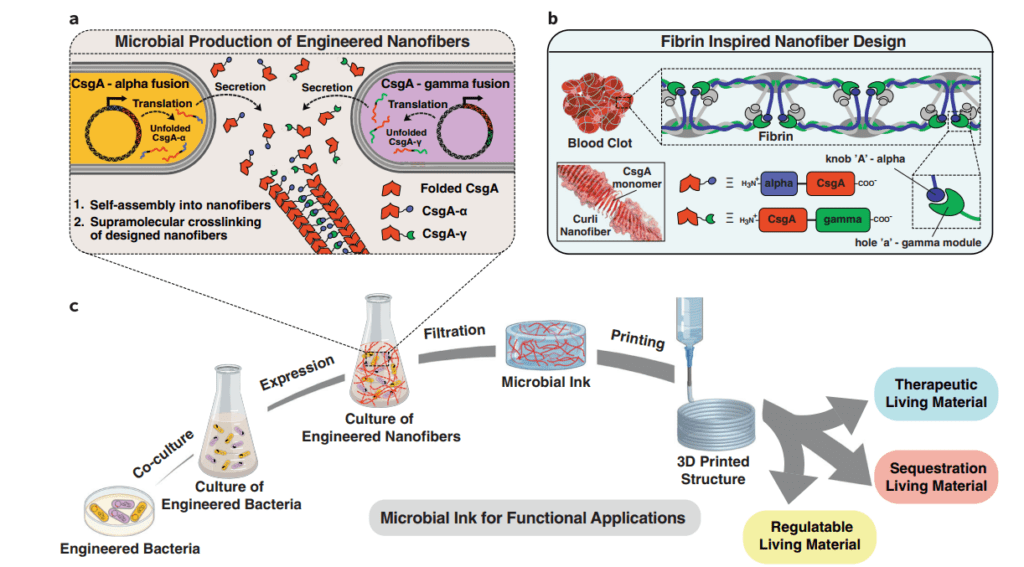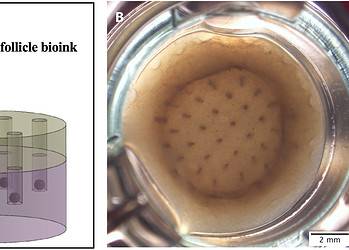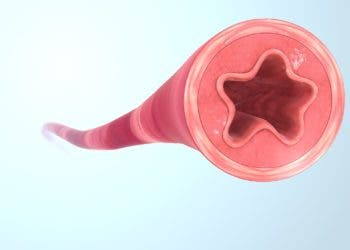
For the first time, scientists have devised a microbial ink entirely made out of bacteria, which can be used to print three-dimensional materials with unique properties, typical of living things. For instance, the technology could be used to sequester toxic chemicals that pollute the environment or release anti-cancer drugs in very specific conditions.
Bioinks are materials used to produce engineered live tissue using 3D printing technology. They’re usually made of living cells enveloped in a 3D molecular scaffold, usually made from a biopolymer gel.
Unlike your typical 3D printer that extrudes an inanimate object based on the specifications of a digital model, bioinks produce tissue-like objects that are constantly morphing. As cells grow and proliferate, they take in substances found outside (like food), metabolize them, and then release different substances.
It’s a whole different process from what you or I typically think when hearing about 3-D printing, but bioinks definitely have their purpose. For instance, this technology can be used to literally print tissues and, ultimately, entire organs.
For their new study, researchers at Virginia Polytechnic Institute and State University, Harvard University, and Northwestern University demonstrated the next iteration of bioink technology. In a world first, they made a printable ink directly made from microbes, with no other additive or polymer present.
“Microbial inks are the new class of bioinks that are produced entirely from the engineered microbes and provide a novel platform to produce bioinks sustainably. The incorporation of engineered microbes into microbial ink enables the fabrication of functional living materials and 3D living architecture having predetermined shapes and patterns for various biotechnological and biomedical applications. Microbial ink could be instrumental in gaining a better understanding of microbiomes and tissue engineering applications. On the other hand, microbial inks could also be utilized for building structural living materials both on Earth and in extraterrestrial habitats. And it is to be noted that for the latter it is difficult to transport all the raw materials from Earth,” Avinash Manjula-Basavanna of the Wyss Institute for Biologically Inspired Engineering at Harvard University told ZME Science.
Manjula-Basavanna’s lab specialized in a novel and exotic field of science known as Engineered Living Materials (ELMs), which basically refers to designing materials composed of living things. These materials can be mighty useful depending on the application and the type of cells employed as the bioink. An ELM can be self-healing, self-regulating, self-regenerating, and highly responsive to the environment. Since they’re biological in nature, such materials are also highly sustainable and recyclable.
“Analogous to a seed that has all the necessary information stored within, to acquire resources from its surroundings and grow to a gigantic tree, the ultimate vision of ELMs field is to program living cells to make macroscopic materials with life-like properties,” said Manjula-Basavanna.
“So far, researchers in the field of ELMs have been able to program living cells to make a wide variety of materials. But, building a three-dimensional material of specific shape, size, and pattern from the engineered cells by a bottom-up approach is rather difficult, and for which one can think of utilizing a 3D printing-based top-down approach. In order to 3D print, one requires a bioink that can favorably harbor the living cells and also facilitate printing into desired 3D architectures. In this regard, we decided to program the extracellular matrix of E. coli biofilm to produce the Microbial Ink.”
From the genetically engineered E. coli, the researchers extracted nanofibers that can be concentrated and printed in desired 3D structures. The ink was then combined with other genetically engineered E. coli microbes, turning the material into an extrudable hydrogel that can ooze from the nozzle of a 3D printer.
This task was a lot harder than it sounds. No one was able to make a bioink solely out of microbes because it needs to have just the right stiffness, viscosity, yield strength, printability, shape, and structural integrity.
“To accomplish this, we introduced a genetically programmed cross-linking strategy by taking inspiration from fibrin, which is a protein involved in the formation of blood clots through the protein-protein interactions of alpha and gamma modules known as the knob-hole interactions. With the help of detailed characterization of the Microbial Ink, we have shown that our strategy is not only effective and successful but also convenient, as it can be produced directly from the microbial culture by a simple filtration protocol,” said Manjula-Basavanna.”It is one of the first examples of tuning the material properties of a biologically derived material through rational genetic engineering. We aim to keep pushing the boundaries along these lines so that their functional properties can compete with (and eventually replace) existing materials that are causing harm to our environment,” added Neel S. Joshi, Associate Professor at the Department of Chemistry and Chemical Biology at Northeastern University and the corresponding author of the new study.
During one experiment, the microbial hydrogel was used to make a material that secretes the anticancer drug azurin in the presence of a certain chemical stimulus. The researchers also made a similar material that sequesters the toxic chemical BPA.
“We think this could be important to help shift our current linear materials manufacturing paradigm (i.e. extract-use-dispose) into something more circular and sustainable (e.g. biofabricate-use-biodegrade),” Joshi said.
The findings appeared in the journal Nature Communications.





